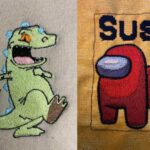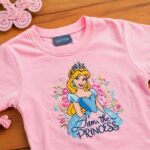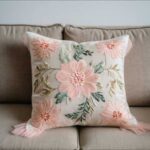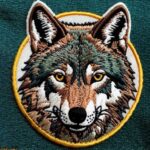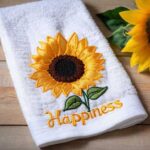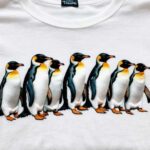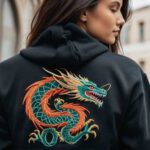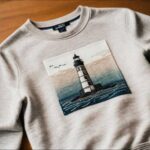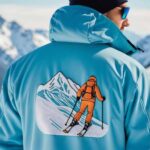Stay Dry In Style
Techniques for Embroidering on Waterproof Fabrics
Introduction
Embroidering on waterproof fabrics is an exciting and challenging endeavor that marries practicality with artistic expression. As the demand for waterproof materials in various applications, ranging from outdoor gear to protective clothing, continues to grow, so does the opportunity to embellish these fabrics with intricate designs that enhance both their functionality and aesthetic appeal. However, waterproof fabrics possess unique properties that can complicate the embroidery process. Their nonporous surfaces, resistance to needle penetration, and the need to maintain their waterrepelling qualities require specialized knowledge and techniques.
In this comprehensive guide, we will delve into the world of waterproof fabrics, exploring their types, properties, and the careful considerations needed for successful embroidery. From selecting the right fabric and preparing it properly to mastering the techniques and tools required, this article aims to equip you with the knowledge and skills to tackle the challenges of embroidering on waterproof materials. Whether you’re a seasoned embroiderer or new to the craft, understanding these critical elements will enable you to create stunning, durable designs that can withstand the elements while maintaining their integrity and beauty. Join us as we navigate the complexities and unlock the creative potential of waterproof fabric embroidery.
Understanding Waterproof Fabrics
Waterproof fabrics are specialized textiles designed to prevent water from penetrating through their surface, making them indispensable in various applications ranging from outdoor gear to high performance sportswear. The fundamental principle behind waterproof fabrics is their ability to create an impermeable barrier against moisture while often maintaining breathability and comfort. This unique combination of properties is achieved through various manufacturing techniques and treatments that distinguish waterproof fabrics from standard materials.
One of the most renowned waterproof fabrics is Gore-Tex, a synthetic material celebrated for its remarkable balance of breathability and waterproofing. Gore-Tex achieves its waterproof properties through a sophisticated membrane that contains microscopic pores. These pores are small enough to block water droplets yet large enough to allow water vapor to escape, ensuring that the wearer remains dry without sacrificing comfort. This characteristic makes Gore Tex an ideal choice for outdoor clothing and equipment, where maintaining body temperature and dryness is crucial.
Another popular waterproof material is ripstop nylon, known for its durability and lightweight nature. Ripstop nylon is woven with a special reinforcing technique that makes it resistant to tearing and ripping. This fabric often features a crosshatch pattern of thick reinforcement threads interwoven at regular intervals, enhancing its strength without significantly increasing its weight. This makes ripstop nylon a preferred choice for outdoor and sports gear, such as tents, backpacks, and jackets, where both durability and weight are critical considerations.
Polyurethane coated fabrics represent another category of waterproof materials, distinguished by their flexible and robust properties. These fabrics are typically treated with a polyurethane coating that forms a waterproof barrier. The coating can vary in thickness, allowing for a range of applications from lightweight rainwear to heavy duty tarps and covers. The versatility of polyurethane coated fabrics makes them suitable for a wide array of uses, offering a balance of water resistance, flexibility, and cost effectiveness.
Understanding the unique properties of waterproof fabrics is essential for achieving successful embroidery results. Unlike traditional textiles, waterproof materials often have a smooth, slick surface that can pose challenges during the embroidery process. This slickness can cause the fabric to slip or shift, leading to misaligned designs and uneven stitching. Therefore, it is crucial to employ specific techniques and tools tailored to the characteristics of waterproof fabrics to ensure the integrity of both the fabric and the embroidery.
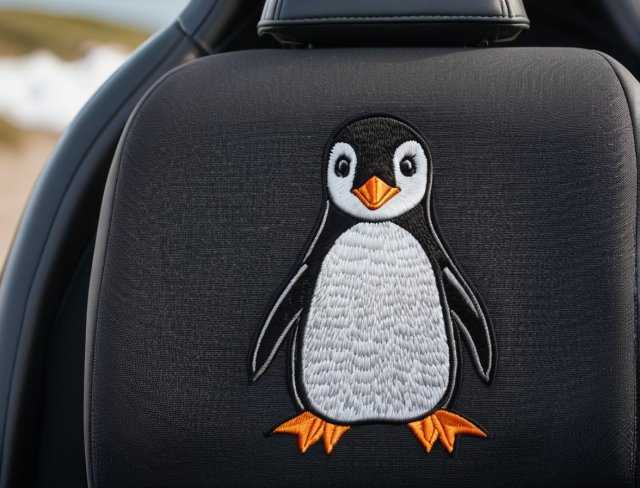
One significant aspect to consider is the fabric’s resistance to needle penetration. Waterproof fabrics are often tightly woven or coated, making it harder for needles to penetrate without causing damage. Selecting the right type of needle is paramount; sharp needles designed for synthetic materials can help achieve clean, precise stitches without compromising the fabric’s waterproof properties. Additionally, using high quality polyester or nylon threads is recommended due to their durability and resistance to moisture, which ensures that the embroidered design remains intact and vibrant over time.
The breathability of waterproof fabrics also plays a critical role in their functionality. Fabrics like Gore Tex, with their microporous membranes, allow perspiration to escape while blocking external moisture. This breathability is essential for maintaining comfort in active wear, preventing the buildup of sweat and heat inside the garment. When embroidering on such fabrics, it is important to consider how the embroidery process might affect the fabric’s breathability. For instance, densely stitched designs may reduce the fabric’s ability to release moisture, so balancing design complexity with functionality is key.
The use of stabilizers is crucial when working with waterproof fabrics. Stabilizers provide the necessary support to prevent the fabric from shifting or puckering during the embroidery process. Depending on the fabric’s thickness and flexibility, different types of stabilizers can be used. Water soluble stabilizers are a popular choice as they can be easily removed after embroidery without affecting the fabric’s waterproof properties. Tear away stabilizers are another option, particularly for thicker fabrics where additional support is needed.
Waterproof fabrics are an essential component in the world of textiles, offering unparalleled protection against moisture while often maintaining breathability and comfort. Understanding the distinct characteristics of materials such as Gore Tex, ripstop nylon, and polyurethane coated fabrics is vital for successful embroidery. By selecting the appropriate tools and techniques, embroiderers can overcome the challenges posed by these fabrics and create stunning, durable designs that stand up to the elements. Whether for outdoor gear, sportswear, or everyday items, mastering the art of embroidering on waterproof fabrics opens up a realm of creative possibilities, ensuring that functionality and style go hand in hand.
Types of Waterproof Fabric Products
Waterproof fabrics are utilized in a broad spectrum of products that span various industries and applications. These materials offer essential protection against moisture, making them invaluable for outdoor, sports, and everyday items. Understanding the different types of waterproof fabric products and their specific uses can help embroiderers choose the right material for their projects and ensure optimal performance and durability.
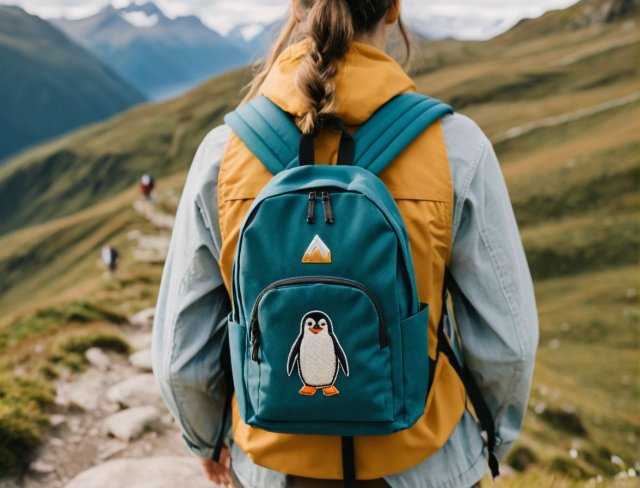
• Outdoor Gear
One of the most prominent applications of waterproof fabrics is in outdoor gear. This category includes items such as tents, backpacks, sleeping bags, and outerwear. These products must withstand harsh weather conditions, ensuring users stay dry and comfortable.
♦ Tents: Modern tents often incorporate waterproof fabrics like ripstop nylon or polyester, which provide a lightweight yet durable solution for shelter. These fabrics are treated with waterproof coatings or laminates that prevent water from penetrating, while also offering tear resistance. Some high end tents use Gore Tex or similar breathable membranes to enhance comfort by allowing moisture vapor to escape.
♦ Backpacks: Waterproof backpacks are essential for hikers, campers, and travelers who need to protect their belongings from rain and moisture. These backpacks typically feature fabrics like polyurethane coated nylon or PVC coated polyester. The waterproof coating ensures that the contents remain dry, even in heavy rain. Sealed seams and waterproof zippers further enhance the protection offered by these products.
♦ Sleeping Bags: Sleeping bags designed for wet conditions often use waterproof and breathable fabrics. Gore Tex is a popular choice, providing an excellent balance between water resistance and breathability. This ensures that the sleeper remains dry while allowing moisture from perspiration to escape, preventing dampness inside the sleeping bag.
♦ Outerwear: Waterproof jackets, pants, and hats are critical for outdoor enthusiasts. Fabrics like Gore-Tex, eVent, and similar membranes are commonly used in these garments. These materials offer exceptional water resistance while maintaining breathability, making them ideal for activities such as hiking, skiing, and mountaineering.
• Sportswear
Waterproof fabrics play a crucial role in sportswear, providing protection against the elements while ensuring comfort and performance.
♦ Running and Cycling Gear: Athletes who train and compete in various weather conditions rely on waterproof jackets, pants, and gloves. These items often use lightweight, breathable fabrics like Gore Tex Active or similar materials that provide protection against rain without compromising mobility and ventilation.
♦ Ski and Snowboard Apparel: Skiers and snowboarders require waterproof gear to stay dry in snowy and wet conditions. High performance fabrics like Dermizax, HyVent, and Gore Tex are used in ski jackets, pants, and gloves. These materials offer excellent waterproofing, windproofing, and breathability, essential for maintaining warmth and comfort on the slopes.
♦ Water Sports Gear: For activities like kayaking, sailing, and surfing, waterproof fabrics are essential. Dry suits and wetsuits often incorporate materials like neoprene with waterproof coatings. These suits provide insulation and protection against cold water while preventing water ingress, ensuring the wearer remains dry and comfortable.
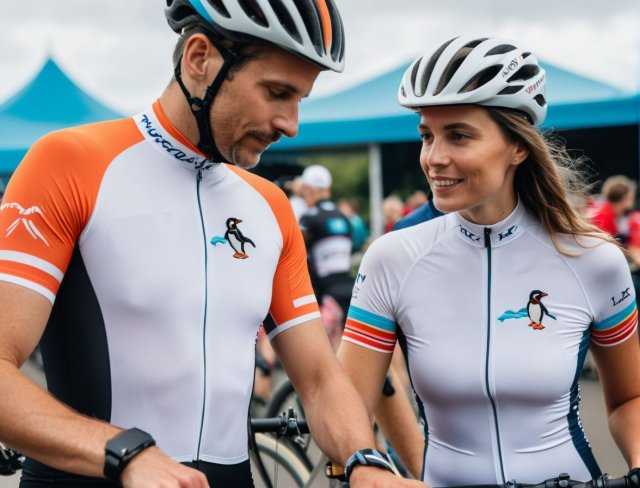
• Everyday Items
Waterproof fabrics are also widely used in everyday items, enhancing their functionality and durability.
♦ Rainwear: Waterproof raincoats, umbrellas, and ponchos are staples for staying dry in wet weather. These products typically use materials like PVC coated polyester or polyurethane coated nylon, offering reliable protection against rain. Lightweight and packable designs make them convenient for everyday use.
♦ Footwear: Waterproof shoes and boots are essential for wet conditions, providing protection against rain and puddles. Materials like Gore Tex are often used in hiking boots, casual shoes, and even some sneakers. These fabrics keep feet dry while allowing breathability, preventing discomfort and blisters.
♦ Bags and Luggage: Waterproof bags, duffels, and luggage ensure that personal items stay dry during travel. These products use durable, waterproof fabrics like TPU coated nylon or PVC. Waterproof zippers and sealed seams enhance their effectiveness, making them ideal for outdoor adventures and urban commuting.
♦ Furniture Covers: Outdoor furniture covers made from waterproof fabrics protect against rain, snow, and UV rays. Materials like vinyl coated polyester or acrylic coated fabrics are commonly used. These covers extend the life of outdoor furniture by preventing moisture damage and fading.
• Industrial and Commercial Applications
Beyond consumer products, waterproof fabrics are vital in various industrial and commercial applications.
♦ Protective Clothing: In industries where exposure to water and chemicals is a risk, waterproof protective clothing is essential. Fabrics like PVC coated polyester or polyurethane coated materials are used in rain suits, aprons, and overalls. These garments protect workers from environmental hazards while ensuring comfort and mobility.
♦ Marine and Nautical Gear: Waterproof fabrics are used extensively in marine applications, from boat covers to sails and tarps. These products require durable, UV resistant, and waterproof materials to withstand harsh marine environments. Fabrics like acrylic coated polyester or PVC coated mesh are popular choices for their strength and longevity.
♦ Medical and Healthcare: In healthcare settings, waterproof fabrics are used in items like mattress covers, medical gowns, and protective barriers. These materials help prevent the spread of moisture and contaminants, ensuring a hygienic environment. Vinyl and polyurethane coated fabrics are commonly used for their waterproof and easy to clean properties.
The versatility and effectiveness of waterproof fabrics make them indispensable in a wide range of products across various industries. From outdoor gear and sportswear to everyday items and industrial applications, these materials provide essential protection against moisture, ensuring durability, functionality, and comfort. Understanding the types of waterproof fabric products and their specific uses can help embroiderers and manufacturers select the right materials for their projects, achieving optimal results and enhancing the performance and longevity of their creations. Embracing the unique properties of waterproof fabrics opens up a world of creative possibilities, allowing for the creation of stylish, functional, and high performance items that stand up to the elements.
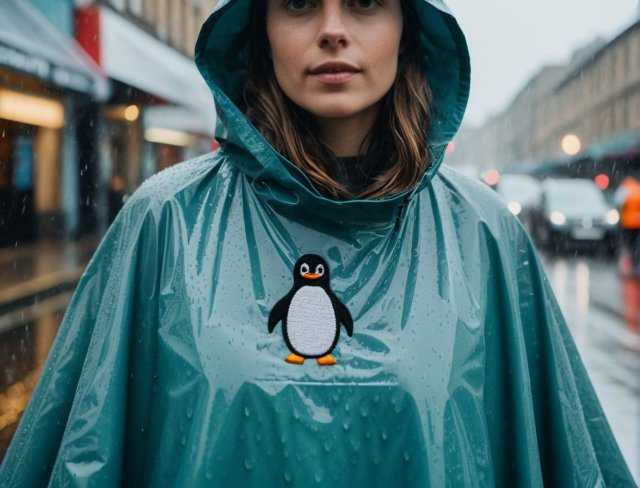
Selecting the Right Waterproof Fabric
Choosing the appropriate waterproof fabric for your embroidery projects is a critical decision that impacts the functionality, durability, and aesthetic appeal of the final product. With a wide array of waterproof materials available, each possessing unique properties, understanding the specific requirements of your project is essential to making an informed choice.
One of the first considerations when selecting a waterproof fabric is the intended use of the finished item. For outdoor gear and apparel, such as jackets, tents, and backpacks, fabrics like Gore-Tex and ripstop nylon are often preferred. Gore-Tex, known for its exceptional breathability and waterproofing, is ideal for high performance outerwear. Its microporous structure allows moisture vapor to escape while preventing water droplets from penetrating, ensuring comfort and dryness during strenuous activities. Ripstop nylon, with its distinctive crosshatch pattern, offers superior tear resistance and durability, making it a popular choice for items subjected to rough use and adverse weather conditions.
For projects requiring lightweight and flexible materials, polyurethane coated fabrics are a versatile option. These fabrics are commonly used in rainwear, sports gear, and lightweight tarps. The polyurethane coating provides a reliable waterproof barrier while maintaining flexibility and ease of movement. This makes them suitable for garments that need to be both protective and comfortable, such as raincoats and athletic wear.
In applications where breathability is less critical, but robust waterproofing is paramount, materials like PVC coated polyester come into play. These fabrics are extensively used in industrial and commercial products, such as protective clothing, boat covers, and heavy duty tarps. PVC coatings offer excellent resistance to water, chemicals, and abrasion, ensuring long lasting performance in harsh environments. However, they tend to be less breathable, which can be a consideration for items worn close to the skin or used in high activity scenarios.
The aesthetic qualities of the fabric also play a crucial role, especially for consumer products like fashion accessories, footwear, and everyday bags. For instance, waxed cotton provides a classic, rugged appearance combined with effective water resistance. This material is often used in stylish outerwear and accessories, where both functionality and fashion are important. Waxed cotton’s unique look and feel, along with its ability to age gracefully, add to the charm of products designed for urban and outdoor use.
When selecting a waterproof fabric, the method of waterproofing is another vital aspect to consider. There are generally three types of waterproofing methods: laminates, coatings, and treatments. Laminates, such as those used in Gore Tex, involve bonding a waterproof membrane to the fabric, creating a durable and breathable barrier. Coatings, like polyurethane or PVC, involve applying a waterproof layer to the fabric’s surface, which can offer varying degrees of flexibility and durability. Treatments, such as DWR (Durable Water Repellent), are chemical applications that enhance a fabric’s water resistance without adding significant weight or affecting breathability. Each method has its advantages and is suited to different applications and performance requirements.
The fabric’s compatibility with embroidery techniques is another critical factor. Waterproof fabrics can pose challenges due to their slick surfaces and resistance to needle penetration. Selecting a fabric that can be securely stabilized and hooped is essential to achieving precise and durable embroidery. Fabrics like ripstop nylon and polyurethane coated materials generally respond well to appropriate stabilization techniques, such as using high quality stabilizers and hooping aids.
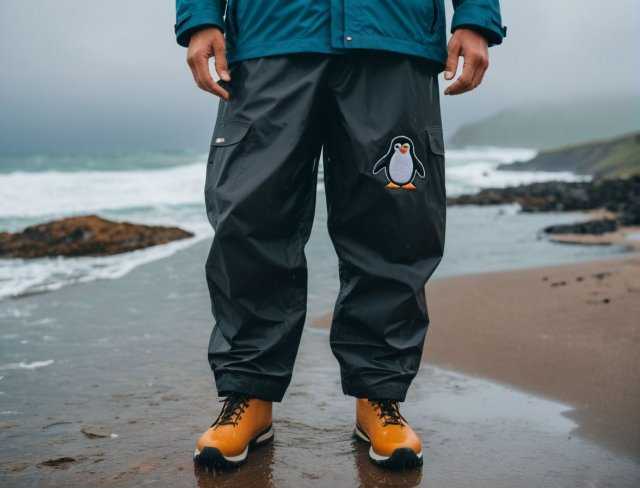
Moreover, considering the maintenance and care of the fabric is important for the longevity of the embroidered item. Waterproof fabrics often require specific cleaning and care instructions to maintain their properties. For instance, Gore Tex garments typically need to be washed with specialized detergents and periodically re treated with water repellent sprays to restore their effectiveness. Understanding these requirements helps ensure that the finished product remains functional and attractive over time.
Selecting the right waterproof fabric involves a comprehensive evaluation of the intended use, performance requirements, aesthetic preferences, and compatibility with embroidery techniques. By carefully considering these factors, embroiderers and designers can choose materials that not only meet the functional needs of their projects but also enhance the overall quality and appeal of the final product. Whether for high performance outdoor gear, stylish everyday items, or industrial applications, the right waterproof fabric can make all the difference in achieving durable, effective, and visually appealing results.
Preparing Waterproof Fabrics for Embroidery
Preparing waterproof fabrics for embroidery involves a series of meticulous steps to ensure that the fabric’s integrity is maintained while achieving high quality embroidery results. Waterproof fabrics, by their very nature, present unique challenges due to their non porous surfaces and resistance to needle penetration. However, with careful preparation and the right techniques, it is possible to create stunning and durable embroidered designs on these materials.
• Choosing the Right Tools and Materials
The first step in preparing waterproof fabrics for embroidery is selecting the appropriate tools and materials. Choosing the right needle is crucial, as waterproof fabrics can be tough and resistant to penetration. A sharp, high quality needle designed for synthetic or heavy fabrics is essential. Needles such as the 75/11 or 90/14 microtex sharp needles are often recommended, as they can pierce the fabric cleanly without causing excessive damage or compromising the waterproof properties.
Thread selection is equally important. Polyester and nylon threads are preferred for waterproof fabrics due to their strength, durability, and resistance to moisture and UV rays. These threads ensure that the embroidery remains vibrant and intact even in harsh conditions. Additionally, using a thread that matches the fabric’s intended use helps maintain the overall performance and appearance of the final product.
• Stabilizing the Fabric
Stabilization is a critical component when embroidering on waterproof fabrics. Due to the slippery and flexible nature of these materials, stabilizers help prevent shifting, puckering, and distortion during the embroidery process. The type of stabilizer used can vary based on the specific fabric and design requirements.
• Hooping Techniques
Proper hooping is essential to ensure that the fabric remains taut and stable throughout the embroidery process. Waterproof fabrics can be challenging to hoop due to their slick surfaces and flexibility. Using hooping aids, such as silicone strips or rubberized hoop inserts, can help secure the fabric and prevent it from slipping. Additionally, using a larger hoop can distribute tension more evenly, reducing the risk of puckering or distortion.

In some cases, floating the fabric on top of the hoop can be a viable option. This technique involves hooping the stabilizer alone and then using adhesive spray or basting stitches to secure the fabric to the stabilizer. Floating can be particularly useful for delicate or difficult to hoop fabrics, as it minimizes the risk of damage.
• Embroidery Design Considerations
When creating or selecting embroidery designs for waterproof fabrics, it’s important to consider the fabric’s properties and intended use. Designs with too many stitches or dense areas can compromise the fabric’s waterproof qualities by creating too many needle penetrations. Opting for lighter, less dense designs can help maintain the fabric’s functionality while still achieving a visually appealing result.
Additionally, avoiding large, solid fill areas can prevent the fabric from becoming too stiff or uncomfortable. Instead, using open, airy designs with running stitches or lighter fill patterns can enhance the fabric’s flexibility and breathability. It’s also important to test the design on a scrap piece of the fabric before committing to the final product, ensuring that the design works well with the chosen material and does not compromise its waterproof properties.
• Testing and Adjusting Machine Settings
Before embroidering on the final piece, it’s essential to test the fabric, needle, thread, stabilizer, and design combination. Testing allows you to adjust machine settings to achieve optimal results. Key settings to consider include:
♦ Tension: Adjusting the tension for both the top thread and bobbin thread can prevent puckering and ensure smooth stitching. Waterproof fabrics often require a balanced tension to accommodate their unique properties.
♦ Speed: Slowing down the machine’s stitching speed can improve control and precision, especially on slick or flexible fabrics. Slower speeds reduce the risk of the fabric shifting and ensure that each stitch is placed accurately.
♦ Stitch Length: Longer stitch lengths can help prevent perforation and maintain the fabric’s integrity. Shorter stitches may create too many needle penetrations, compromising the waterproof properties.
After completing the embroidery, careful removal of the stabilizer is essential to maintain the fabric’s waterproof properties. If using water soluble stabilizers, ensure that all residue is thoroughly rinsed out, leaving the fabric clean and free from stabilizer remnants. For tear away or cut away stabilizers, trim away the excess carefully without damaging the embroidery or fabric.
In some cases, it may be necessary to reapply a waterproof treatment to the fabric after embroidery. This can help restore the fabric’s original waterproof properties, especially if the embroidery process has compromised them. Various spray on or wash in treatments are available that can enhance the fabric’s water resistance without affecting the embroidery.
Preparing waterproof fabrics for embroidery involves a careful balance of selecting the right tools and materials, using appropriate stabilization and hooping techniques, considering design and machine settings, and performing thorough testing and post embroidery care. By following these steps, embroiderers can successfully work with waterproof fabrics, creating durable, functional, and visually appealing embroidered items that stand up to the elements.
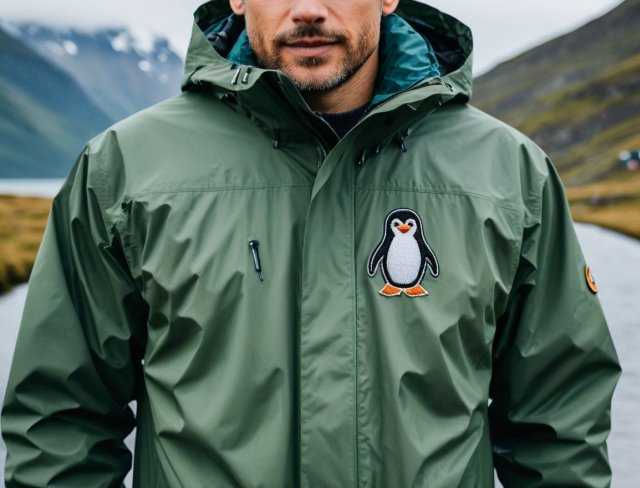
Techniques for Embroidering on Waterproof Fabrics
Embroidery on waterproof fabrics presents unique challenges due to their non porous surfaces, resistance to needle penetration, and the need to maintain their water repelling properties. However, by employing specific techniques and using the right tools, it is possible to create beautiful and durable embroidered designs on these fabrics. Below, we delve into detailed, comprehensive, and compelling techniques for embroidering on waterproof fabrics.
• Selecting the Appropriate Needle
Using the correct needle is crucial when embroidering on waterproof fabrics. Standard embroidery needles can cause significant damage to these materials, leading to leaks and tears. It is essential to choose a needle that is sharp enough to penetrate the fabric cleanly without causing excessive damage.
Microtex (Sharp) Needles: These needles have a very fine, sharp point that can easily pierce through tough fabrics like ripstop nylon, Gore Tex, and PVC coated polyester. Sizes 75/11 or 90/14 are often recommended for their ability to handle the resistance offered by waterproof materials.
Ballpoint Needles: For stretchy waterproof fabrics, such as those used in sportswear, a ballpoint needle might be more suitable. These needles push the fibers aside rather than cutting through them, which reduces the risk of damaging the fabric’s integrity.
• Using High Quality Threads
The choice of thread is equally important. Waterproof fabrics often require strong, durable threads that can withstand the elements.
Polyester Thread: This is a preferred choice for embroidering on waterproof fabrics due to its strength, durability, and resistance to UV rays and moisture. Polyester thread retains its color and integrity even when exposed to harsh conditions.
Nylon Thread: Another good option, nylon thread, offers excellent strength and flexibility. It is especially suitable for applications requiring high durability and resistance to wear and tear.
• Proper Stabilization
Stabilizing waterproof fabrics is essential to prevent shifting, puckering, and distortion during embroidery. The type of stabilizer used will depend on the fabric and the complexity of the design.
Cut Away Stabilizers: These are ideal for thick waterproof fabrics as they provide robust support and ensure the fabric remains stable throughout the embroidery process. They are particularly useful for dense or intricate designs.
Tear Away Stabilizers: Suitable for lighter waterproof fabrics, tear away stabilizers offer sufficient support and are easy to remove without damaging the fabric. They are ideal for less dense designs.
Water Soluble Stabilizers: These are beneficial when the stabilizer needs to be completely removed to maintain the fabric’s waterproof properties. They dissolve in water, leaving no residue behind.
Adhesive Stabilizers: These stabilizers can be used to secure the fabric in the hoop, preventing it from shifting during embroidery. They are particularly useful for slick or flexible waterproof fabrics.
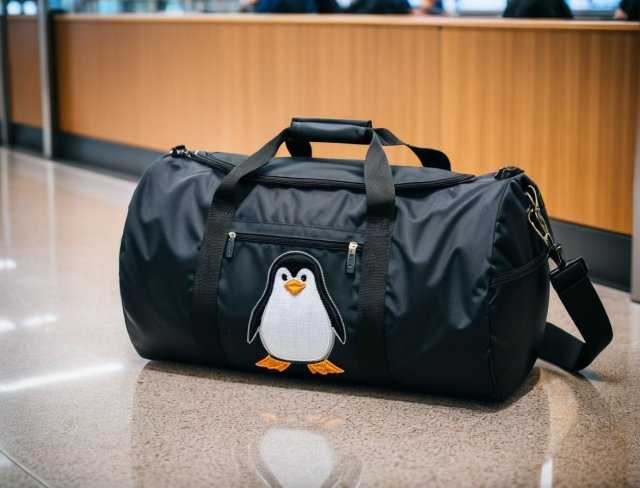
• Hooping Techniques
Proper hooping techniques are critical to ensure that the fabric remains taut and stable during embroidery. Waterproof fabrics can be slippery and challenging to hoop.
Hooping Aids: Silicone strips or rubberized hoop inserts can help secure the fabric and prevent slipping. These aids improve the grip of the hoop on the fabric, ensuring it stays in place.
Floating Method: In cases where hooping directly onto the fabric is difficult, floating the fabric on top of the hooped stabilizer can be an effective method. This involves hooping the stabilizer alone and using temporary adhesive spray or basting stitches to secure the fabric to the stabilizer.
• Adjusting Machine Settings
Embroidery machines often need specific adjustments when working with waterproof fabrics to achieve optimal results.
Tension Settings: Adjusting the tension for both the top thread and bobbin thread can help prevent puckering and ensure smooth stitching. Waterproof fabrics often require a balanced tension to accommodate their unique properties.
Stitch Speed: Slowing down the machine’s stitching speed can improve control and precision, especially on slick or flexible fabrics. A slower speed reduces the risk of the fabric shifting and ensures each stitch is placed accurately.
Stitch Length: Longer stitch lengths can help prevent perforation and maintain the fabric’s integrity. Shorter stitches may create too many needle penetrations, which can compromise the waterproof properties of the fabric.
• Design Considerations
When creating or selecting designs for embroidery on waterproof fabrics, it is important to consider the fabric’s properties and intended use.
Density: Designs with too many stitches or dense areas can compromise the fabric’s waterproof qualities by creating too many needle penetrations. Lighter, less dense designs help maintain the fabric’s functionality while still achieving a visually appealing result.
Fill Patterns: Avoiding large, solid fill areas can prevent the fabric from becoming too stiff or uncomfortable. Instead, using open, airy designs with running stitches or lighter fill patterns can enhance the fabric’s flexibility and breathability.
Test Runs: It’s crucial to test the design on a scrap piece of the fabric before committing to the final product. This ensures that the design works well with the chosen material and does not compromise its waterproof properties.
Post Embroidery Care
After completing the embroidery, careful removal of the stabilizer is essential to maintain the fabric’s waterproof properties.
Water Soluble Stabilizers: If using water soluble stabilizers, ensure that all residue is thoroughly rinsed out, leaving the fabric clean and free from stabilizer remnants.
Reapplication of Waterproof Treatment: In some cases, it may be necessary to reapply a waterproof treatment to the fabric after embroidery. Various spray on or wash in treatments can restore the fabric’s original waterproof properties without affecting the embroidery.
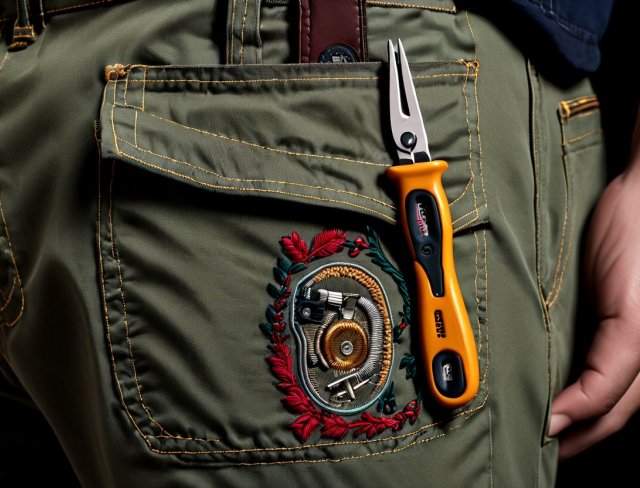
Reinforcing Embroidered Areas
To ensure the durability and longevity of the embroidery on waterproof fabrics, reinforcing the embroidered areas can be beneficial.
Seam Sealant: Applying a seam sealant to the back of the embroidery can help maintain the waterproof integrity of the fabric. Seam sealant products are designed to seal the needle holes created during the embroidery process, preventing water from penetrating through these tiny openings.
Backing Fabric: Adding a layer of waterproof backing fabric to the embroidered area can also enhance durability and waterproofing. This additional layer acts as a barrier, protecting the embroidery and the fabric from moisture.
Machine embroidering on waterproof fabrics requires a combination of selecting the right tools, using proper stabilization and hooping techniques, adjusting machine settings, considering design elements, and ensuring post embroidery care. By following these techniques, embroiderers can create high quality, durable, and visually appealing designs on waterproof fabrics, maintaining the functional integrity of the material while achieving stunning results.
Common Challenges and Solutions
Embroidering on waterproof fabrics can present a range of challenges due to the unique properties of these materials. Understanding these common issues and implementing effective solutions is essential for achieving high quality, durable, and visually appealing results. Below, we delve into the most frequent challenges faced when working with waterproof fabrics and provide in depth, comprehensive, and compelling solutions to address them.
• Fabric Shifting and Slipping
Challenge: One of the primary challenges with waterproof fabrics is their tendency to shift and slip during the embroidery process. This can lead to misaligned designs, puckering, and uneven stitches.
Solution:
Use of Adhesive Stabilizers: Applying an adhesive stabilizer to the back of the fabric can help keep it in place. Adhesive stabilizers provide a temporary bond that prevents the fabric from shifting as you embroider.
Hooping Aids: Utilizing hooping aids, such as silicone strips or rubberized hoop inserts, can improve the grip of the hoop on the fabric. This helps keep the fabric taut and secure during embroidery.
Floating Technique: For fabrics that are particularly difficult to hoop, floating the fabric on top of the hooped stabilizer can be effective. Secure the fabric to the stabilizer using temporary adhesive spray or basting stitches.
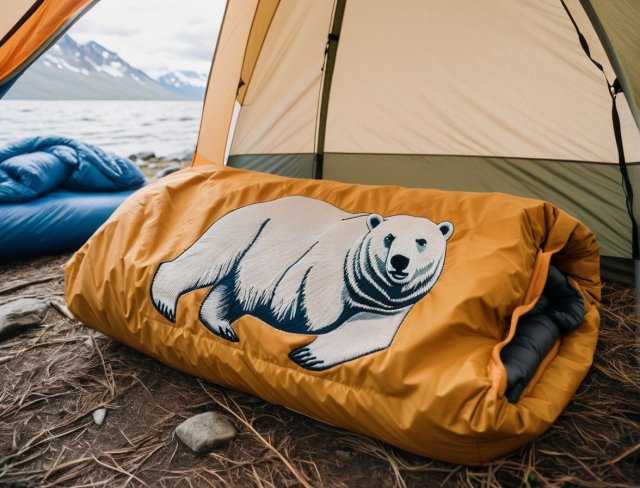
• Needle Penetration and Fabric Damage
Challenge: Waterproof fabrics are often tough and resistant to needle penetration, which can cause the needle to skip stitches or damage the fabric by creating large, unsightly holes.
Solution:
Sharp Needles: Using sharp, high quality needles designed for synthetic or heavy fabrics is essential. Microtex (sharp) needles in sizes 75/11 or 90/14 can pierce through tough fabrics cleanly without causing excessive damage.
Appropriate Needle Size: Ensure the needle size is appropriate for the thickness and type of waterproof fabric. A larger needle may be necessary for thicker materials, while a smaller, finer needle may work better for lighter fabrics.
Testing and Adjustment: Always test the needle on a scrap piece of the fabric before starting the embroidery. Adjust needle size and type as needed to achieve the best results without damaging the fabric.
• Maintaining Waterproof Properties
Challenge: The process of embroidering on waterproof fabrics involves puncturing the material with a needle, which can compromise the fabric’s waterproof properties by creating holes that allow water to seep through.
Solution:
Seam Sealant: Applying a seam sealant to the back of the embroidery can help maintain the waterproof integrity of the fabric. Seam sealants are designed to seal the needle holes created during the embroidery process, preventing water from penetrating through these tiny openings.
Waterproof Backing Fabric: Adding a layer of waterproof backing fabric to the embroidered area can also enhance durability and waterproofing. This additional layer acts as a barrier, protecting the embroidery and the fabric from moisture.
Less Dense Designs: Opting for lighter, less dense designs can reduce the number of needle penetrations, thereby maintaining more of the fabric’s original waterproof properties. Avoiding large, solid fill areas can also prevent the fabric from becoming too stiff or uncomfortable.
• Puckering and Distortion
Challenge: Puckering and distortion of the fabric around the embroidery are common issues when working with waterproof materials, often due to the fabric’s resistance to being stretched and hooped tightly.
Solution:
Proper Stabilization: Using the correct type and amount of stabilizer is crucial. Cut away stabilizers provide robust support for thicker fabrics, while tear away stabilizers are suitable for lighter materials. For fabrics where complete removal is necessary, water soluble stabilizers can be used.
Hooping Techniques: Ensure the fabric is hooped tightly and securely. Using hooping aids or the floating technique can help achieve a stable and taut fabric surface. Adjusting the hoop tension to match the fabric type is also important.
Machine Settings: Adjusting the machine’s tension settings can prevent puckering. Balanced tension for both the top thread and bobbin thread ensures smooth stitching. Slowing down the machine’s stitching speed can also improve control and precision, reducing the risk of puckering and distortion.
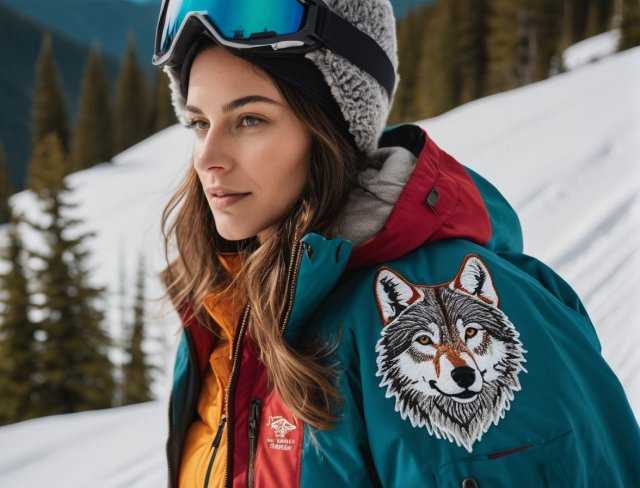
• Thread Breakage and Tangling
Challenge: Thread breakage and tangling are common problems when embroidering on waterproof fabrics, often due to the fabric’s resistance and the increased friction caused by the tough material.
Solution:
High Quality Threads: Using high quality polyester or nylon threads designed for heavy duty applications can reduce breakage. These threads are stronger and more resistant to friction and wear.
Correct Tension: Ensuring the machine’s thread tension is correctly adjusted can prevent excessive stress on the thread, reducing the likelihood of breakage and tangling.
Regular Maintenance: Keeping the embroidery machine well maintained, with regular cleaning and oiling, can help ensure smooth operation and reduce thread related issues. Checking for burrs or rough spots on the needle or needle plate can also prevent thread breakage.
• Fabric Flexibility and Embroidery Stability
Challenge: Waterproof fabrics, especially those that are lightweight and flexible, can be difficult to stabilize, leading to issues with embroidery stability and precision.
Solution:
Layering Stabilizers: Using multiple layers of stabilizers can provide the necessary support for flexible fabrics. Combining a cut away or tear away stabilizer with a water soluble topper can enhance stability while allowing for easy removal.
Stitch Density Adjustments: Reducing the stitch density in the design can help maintain the fabric’s flexibility and prevent it from becoming too stiff. Lighter designs with fewer stitches are less likely to distort the fabric.
Hooping Assistance: For very flexible fabrics, using hooping assistance tools, such as spray adhesives or basting stitches, can help keep the fabric in place and ensure a stable embroidery surface.
Embroidering on waterproof fabrics requires careful consideration of the unique challenges posed by these materials. By selecting the appropriate needles, threads, stabilizers, and hooping techniques, and by making necessary adjustments to machine settings and design elements, embroiderers can overcome these challenges and achieve high quality, durable, and visually appealing results. Understanding and addressing common issues such as fabric shifting, needle penetration, maintaining waterproof properties, puckering, thread breakage, and fabric flexibility ensures that the final embroidered product is both functional and aesthetically pleasing.
Conclusion
Embroidery on waterproof fabrics, while presenting unique challenges, is a highly rewarding endeavor that combines functionality with aesthetic appeal. Understanding the intricacies of these materials, from their diverse types and properties to their specific requirements for preparation and embroidery techniques, is crucial for achieving optimal results. Selecting the right waterproof fabric involves careful consideration of the fabric’s intended use, durability, and water resistance, ensuring the material aligns with the project’s needs. Preparing the fabric with suitable stabilizers, proper hooping methods, and selecting appropriate needles and threads are foundational steps that set the stage for successful embroidery.
When embroidering, employing specialized techniques such as adjusting machine settings, using sharp needles, and choosing high quality threads can significantly enhance the quality of the final product. Addressing common challenges like fabric shifting, needle penetration issues, and maintaining waterproof properties through strategic solutions ensures the fabric’s integrity and functionality are preserved. Techniques such as using adhesive stabilizers, hooping aids, and seam sealants help mitigate these challenges, allowing for precise and durable embroidery.
Mastering machine embroidery on waterproof fabrics requires a blend of knowledge, skill, and attention to detail. By understanding the characteristics of waterproof fabrics, preparing them correctly, and utilizing effective embroidery techniques, one can create stunning, resilient designs that withstand the elements while maintaining their beauty and functionality. Whether for outdoor gear, protective clothing, or stylish accessories, the ability to embroider on waterproof fabrics opens up a world of creative possibilities, enabling embroiderers to produce products that are both practical and visually captivating.
Now that you have read through this article, feel free to SHOP for products we have created. If you are looking for something special which isn’t in our store, feel free to contact us.


